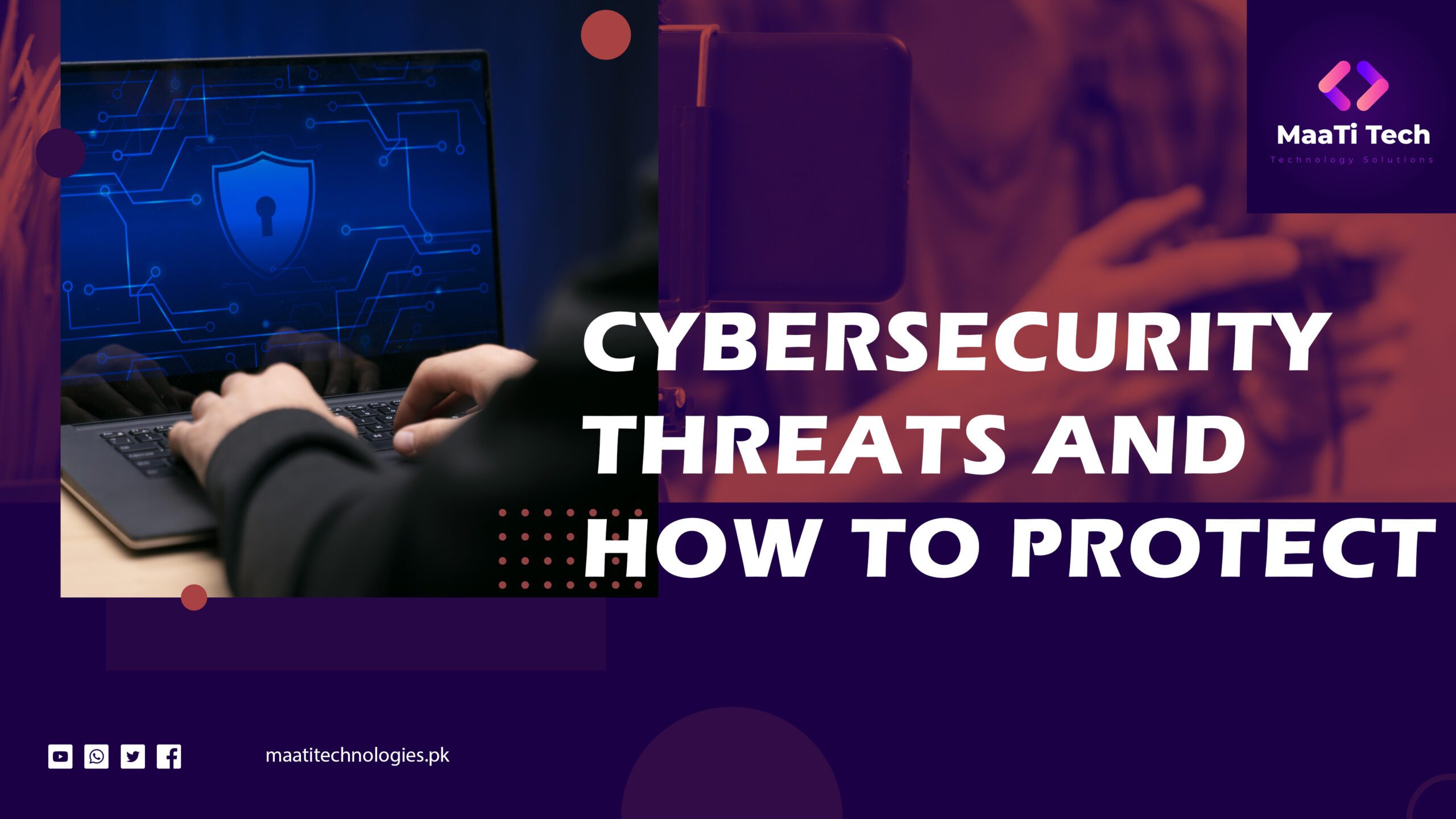Cybersecurity Threats and How to Protect Your Data
Introduction to Cybersecurity
Definition of Cybersecurity:
Cybersecurity refers to the practice of protecting systems, networks, and programs from digital attacks. These cyberattacks are usually aimed at accessing, changing, or destroying sensitive information, extorting money from users, or interrupting normal business processes. Implementing effective cybersecurity measures is particularly challenging today because there are more devices than people, and attackers are becoming more innovative.
Table of Contents
Importance of Cybersecurity in the Modern World:
As our reliance on digital technologies increases, so does the frequency and sophistication of cyber threats. Cybersecurity is crucial not just for protecting personal and financial data but also for maintaining the trust and integrity of the digital infrastructures that drive our economies. In an interconnected world, where data is a new form of currency, safeguarding this data is paramount for individuals, businesses, and governments alike.
Overview of Common Cybersecurity Threats:
Cybersecurity threats have evolved significantly over the past few decades. Initially, they were relatively simple, involving basic viruses and worms. However, with the advent of advanced technologies, threats have become more complex and diversified. Today, they range from malware and phishing to sophisticated attacks like ransomware and advanced persistent threats (APTs). Understanding these threats is the first step in defending against them.

Types of Cybersecurity Threats
Malware
- Definition and Types (Viruses, Worms, Trojans, etc.):
Malware, short for malicious software, is any software intentionally designed to cause damage to a computer, server, or computer network. Types of malware include viruses, which attach themselves to clean files and spread to other files, worms, which exploit vulnerabilities to spread across networks, and Trojans, which disguise themselves as legitimate software to trick users into installing them. - How Malware Infects Systems:
Malware can infect systems through various means, including phishing emails, malicious downloads, or compromised websites. Once inside a system, malware can perform a variety of functions, from stealing sensitive information to disrupting operations or even taking control of entire systems.
REALTED: Web Application Development Start Building Today
Phishing Attacks
- Definition and Examples of Phishing:
Phishing is a form of social engineering where attackers deceive individuals into providing sensitive information, such as usernames, passwords, and credit card numbers. This is typically done through emails that appear to be from legitimate sources. For example, a user might receive an email from what looks like their bank, asking them to verify their account details. - Techniques Used in Phishing:
Phishing techniques have evolved from simple emails to more sophisticated methods such as spear phishing, where attackers tailor their messages to specific individuals, and whaling, which targets high-profile individuals like CEOs. These attacks often exploit human psychology, making them difficult to detect and prevent.
Ransomware
- Understanding Ransomware:
Ransomware is a type of malware that encrypts the victim’s files, making them inaccessible, and demands a ransom for the decryption key. Ransomware attacks have been on the rise, with attackers targeting individuals, businesses, and even critical infrastructure. - Case Studies of Major Ransomware Attacks:
One of the most notorious ransomware attacks was the WannaCry attack in 2017, which affected over 200,000 computers across 150 countries. Another example is the 2021 Colonial Pipeline attack, where a ransomware attack led to a fuel supply disruption in the United States, causing widespread panic and economic impact.
Denial of Service (DoS) Attacks
- What are DoS and DDoS Attacks?:
A Denial of Service (DoS) attack aims to shut down a machine or network, making it inaccessible to its intended users. This is typically done by flooding the target with excessive requests, overwhelming the system. A Distributed Denial of Service (DDoS) attack is a more advanced version, where the attack is launched from multiple compromised devices, often spread across the globe. - Impact of DoS Attacks on Businesses:
DoS and DDoS attacks can have severe consequences for businesses, including loss of revenue, damaged reputation, and compromised customer trust. For instance, in 2016, a massive DDoS attack targeted Dyn, a major DNS provider, disrupting services for several major websites including Twitter, Netflix, and PayPal.
Insider Threats
- What are Insider Threats?:
Insider threats occur when someone within an organization, such as an employee or contractor, intentionally or unintentionally compromises the organization’s security. This can happen through the misuse of access privileges, accidental disclosure of sensitive information, or malicious actions. - Examples of Insider Threats in Organizations:
One notable example is the Edward Snowden case, where a former NSA contractor leaked classified information to the public. Another example is the Tesla case in 2020, where a disgruntled employee sabotaged the company’s internal systems, causing significant operational disruption.
Man-in-the-Middle (MitM) Attacks
- How MitM Attacks Work:
In a Man-in-the-Middle (MitM) attack, the attacker intercepts and potentially alters the communication between two parties without their knowledge. This can occur over unsecured networks, allowing the attacker to eavesdrop on or manipulate the data being exchanged. - Real-world Examples of MitM Attacks:
A famous example of a MitM attack is the 2011 DigiNotar breach, where attackers issued fraudulent certificates, allowing them to intercept and decrypt communications between users and trusted websites. This led to a significant loss of trust in the certificate authority system.

SQL Injection Attacks
- Understanding SQL Injection:
SQL injection is a code injection technique that allows attackers to interfere with the queries an application makes to its database. This can result in unauthorized access to data, data manipulation, or even complete control over the database. - Prevention of SQL Injection Attacks:
Preventing SQL injection attacks involves implementing prepared statements with parameterized queries, escaping all user-supplied input, and regularly reviewing and testing code for vulnerabilities.
Zero-Day Exploits
- What are Zero-Day Exploits?:
Zero-day exploits are vulnerabilities in software that are unknown to the vendor and, therefore, have no patch or fix available. Attackers exploit these vulnerabilities before the vendor becomes aware and can issue a patch, making them extremely dangerous. - Famous Zero-Day Exploits in History:
One of the most well-known zero-day exploits is the Stuxnet worm, discovered in 2010, which targeted Iranian nuclear facilities. Another example is the Heartbleed bug in 2014, which exposed a significant vulnerability in the OpenSSL cryptography library, affecting millions of websites.
Advanced Persistent Threats (APTs)
- Characteristics of APTs:
Advanced Persistent Threats (APTs) are prolonged and targeted cyberattacks in which an intruder gains access to a network and remains undetected for an extended period. APTs are typically carried out by well-funded and skilled attackers, often state-sponsored, and target high-value information such as intellectual property or government data. - Case Studies of APTs:
The APT1 group, believed to be a unit of the Chinese military, conducted numerous cyber-espionage activities, targeting multiple industries across the globe. Another example is the Russian APT group Fancy Bear, known for its attacks on government institutions and the 2016 U.S. election.
VISIT NOW: Hire the Best WordPress Website Developers
Social Engineering Attacks
- Definition and Techniques:
Social engineering involves manipulating individuals into performing actions or divulging confidential information. Techniques include pretexting, where the attacker creates a fabricated scenario to obtain information, and baiting, where the attacker offers something enticing to trick the victim. - Real-world Examples and Impact:
The 2013 Target data breach, where attackers used social engineering to gain access to the company’s network, resulted in the theft of 40 million credit and debit card records. Another example is the 2020 Twitter hack, where attackers used social engineering to gain access to high-profile accounts.
The Evolution of Cybersecurity Threats
Early Cybersecurity Threats (1980s-2000s):
In the early days of the internet, cybersecurity threats were relatively simple, often involving basic viruses and worms spread through floppy disks and early networks. The Morris Worm in 1988 was one of the first major internet worms, affecting about 10% of all internet-connected computers at the time.
Modern Cybersecurity Threats (2000s-Present):
As the internet grew, so did the complexity and scale of cyber threats. The 2000s saw the rise of sophisticated malware, ransomware, and phishing attacks. The emergence of state-sponsored cyberattacks and organized cybercrime syndicates further escalated the threat landscape.
Future Predictions for Cybersecurity Threats:
Looking ahead, cybersecurity threats are expected to become even more sophisticated, with the rise of artificial intelligence (AI) and machine learning (ML) potentially being used by both attackers and defenders. The growing interconnectivity of devices through the Internet of Things (IoT) also presents new challenges, as does the increasing reliance on cloud computing.

How Cybersecurity Threats Affect Individuals
Financial Impact:
Cybersecurity threats can have devastating financial consequences for individuals. Phishing scams and ransomware attacks can result in significant financial losses, either through direct theft of funds or through the cost of recovering from an attack.
Personal Data Breaches:
Personal data breaches occur when unauthorized individuals gain access to sensitive personal information, such as social security numbers, credit card details, or medical records. These breaches can lead to identity theft, financial fraud, and a loss of privacy.
Identity Theft:
Identity theft occurs when an attacker uses someone else’s personal information, such as their name, social security number, or credit card details, to commit fraud. Victims of identity theft may face years of financial and legal challenges as they work to restore their identity.
Psychological Effects on Victims:
Beyond the financial and legal consequences, victims of cybersecurity threats often experience significant psychological effects, including stress, anxiety, and a loss of trust in digital systems. The feeling of violation and helplessness can have long-lasting emotional impacts.
How Cybersecurity Threats Affect Businesses
Financial Losses:
For businesses, the financial impact of cybersecurity threats can be enormous. The costs of responding to a breach, repairing damaged systems, and compensating affected customers can run into millions of dollars. In some cases, businesses may be forced to shut down entirely as a result of a cyberattack.
Reputational Damage:
A cyberattack can severely damage a company’s reputation, leading to a loss of customer trust and a decline in business. High-profile breaches often make headlines, causing long-term harm to a company’s brand and market value.
Legal Consequences:
Businesses may face legal consequences following a cybersecurity breach, particularly if they are found to have been negligent in protecting customer data. This can result in lawsuits, fines, and other regulatory actions.
Operational Disruptions:
Cyberattacks can disrupt business operations, leading to downtime, loss of productivity, and missed opportunities. For example, a DDoS attack can take down a company’s website, preventing customers from accessing services and causing significant revenue loss.
Cybersecurity in Different Sectors
Cybersecurity in Finance
- Major Cybersecurity Threats in the Financial Sector:
The financial sector is a prime target for cybercriminals due to the high value of the data and money involved. Common threats include phishing attacks, ransomware, and insider threats. Financial institutions must implement robust security measures to protect against these risks. - Case Studies: Financial Sector Breaches:
The 2014 JPMorgan Chase data breach affected 76 million households and 7 million small businesses, making it one of the largest data breaches in history. Another example is the Bangladesh Bank heist in 2016, where attackers used malware to steal $81 million from the bank’s accounts at the Federal Reserve Bank of New York.
Cybersecurity in Healthcare
- Impact of Cybersecurity Threats on Healthcare:
Cybersecurity threats in healthcare can have life-threatening consequences. For example, ransomware attacks on hospitals can disrupt critical medical services, putting patients’ lives at risk. Additionally, breaches of medical records can lead to identity theft and other forms of fraud. - Protecting Patient Data:
Healthcare providers must implement strict data protection measures, including encryption, access controls, and regular security audits. The Health Insurance Portability and Accountability Act (HIPAA) in the United States sets standards for protecting patient information, but healthcare organizations must go beyond compliance to ensure comprehensive security.
Cybersecurity in Government
- Governmental Cybersecurity Threats:
Governments are increasingly targeted by cyberattacks, ranging from espionage to disruptive attacks on critical infrastructure. These threats can have national security implications and require coordinated responses at the highest levels. - Notable Cyber Attacks on Government Entities:
The 2015 attack on the U.S. Office of Personnel Management (OPM) compromised the personal information of over 21 million federal employees. Another example is the 2020 SolarWinds hack, which affected multiple U.S. government agencies and highlighted the vulnerabilities in the supply chain.
Cybersecurity in Retail
- Retail Sector Cybersecurity Risks:
The retail sector faces unique cybersecurity challenges, including the protection of payment card information and customer data. As e-commerce grows, retailers must be vigilant against threats such as malware, phishing, and DDoS attacks. - Case Studies: Cybersecurity Breaches in Retail:
The 2013 Target data breach, where attackers accessed 40 million credit and debit card records, is one of the most well-known retail sector breaches. Another example is the 2014 Home Depot breach, which exposed 56 million payment card numbers.
Cybersecurity in Education
- Cybersecurity Challenges in Educational Institutions:
Educational institutions face cybersecurity threats from a variety of sources, including students, staff, and external attackers. These threats can result in data breaches, intellectual property theft, and disruptions to academic operations. - Protecting Student and Faculty Data:
To protect sensitive data, educational institutions must implement robust security measures, including network monitoring, access controls, and regular security training for staff and students. Additionally, schools should work closely with cybersecurity experts to stay ahead of emerging threats.
Tools and Technologies for Protecting Against Cybersecurity Threats
Firewalls:
Firewalls are the first line of defense against cyberattacks, acting as a barrier between a trusted internal network and untrusted external networks. They can filter incoming and outgoing traffic based on predetermined security rules, preventing unauthorized access.
Antivirus and Anti-Malware Software:
Antivirus and anti-malware software are essential tools for detecting and removing malicious software from systems. These programs scan files and applications for known threats, quarantine infected files, and protect against future attacks through regular
updates.
Encryption Technologies:
Encryption is the process of converting data into a coded format that can only be accessed by authorized users with the correct decryption key. Encryption is crucial for protecting sensitive data, particularly during transmission over the internet.
Multi-Factor Authentication (MFA):
Multi-factor authentication adds an extra layer of security by requiring users to provide two or more verification factors to access a system. This could include something the user knows (a password), something they have (a security token), and something they are (a fingerprint).
Intrusion Detection Systems (IDS):
Intrusion Detection Systems (IDS) monitor network traffic for suspicious activity and issue alerts when potential threats are detected. IDS can be used to detect a wide range of threats, including malware, unauthorized access attempts, and policy violations.
Security Information and Event Management (SIEM) Systems:
SIEM systems collect and analyze security data from various sources across an organization, providing real-time insights into potential threats. SIEM systems can help organizations identify and respond to incidents quickly, minimizing damage and disruption.
Secure Network Architectures:
A secure network architecture is designed to protect data and resources by segmenting networks, restricting access based on user roles, and implementing strong security controls at every layer. This reduces the attack surface and makes it harder for attackers to move laterally within a network.
Cloud Security Solutions:
As more organizations move to the cloud, cloud security solutions are essential for protecting data and applications hosted in cloud environments. These solutions include encryption, access controls, and continuous monitoring to ensure the security of cloud-based assets.
Best Practices for Protecting Your Data
Regular Software Updates and Patching:
Keeping software up to date is one of the most effective ways to protect against cybersecurity threats. Regular updates and patching fix known vulnerabilities that attackers could exploit, reducing the risk of a successful attack.
Strong Password Policies:
Implementing strong password policies is critical for protecting accounts and systems. Passwords should be complex, unique for each account, and changed regularly. Organizations should also encourage the use of password managers to help users manage their credentials securely.
Safe Browsing Practices:
Safe browsing practices involve being cautious about the websites you visit and the links you click. Users should avoid visiting suspicious websites, downloading files from unknown sources, and entering personal information on unsecured websites.
Email Security Tips:
Email is a common vector for phishing attacks and malware. To protect against email-based threats, users should be cautious about opening attachments or clicking links in unsolicited emails, verify the sender’s identity, and report any suspicious emails to their IT department.
Securing Mobile Devices:
Mobile devices are increasingly targeted by cybercriminals, making mobile security a priority. Users should secure their devices with strong passwords or biometric authentication, enable remote wipe features, and be cautious about downloading apps from unknown sources.
Using Virtual Private Networks (VPNs):
A Virtual Private Network (VPN) encrypts your internet connection, making it more secure and protecting your data from eavesdropping, especially when using public Wi-Fi networks. VPNs are an essential tool for maintaining privacy and security online.
Regular Data Backups:
Regular data backups are crucial for recovering from cyberattacks, such as ransomware, that result in data loss. Backups should be stored in a secure, offsite location and tested regularly to ensure that data can be restored quickly and completely.
Employee Training and Awareness Programs:
Human error is a significant factor in many cybersecurity incidents. Organizations should invest in regular training and awareness programs to educate employees about the latest threats, safe computing practices, and how to respond to potential security incidents.

How to Respond to a Cybersecurity Threat
Identifying a Cybersecurity Breach:
The first step in responding to a cybersecurity threat is identifying that a breach has occurred. This involves monitoring systems for unusual activity, such as unauthorized access attempts, changes to files, or a sudden increase in network traffic.
Containing and Mitigating the Threat:
Once a breach is identified, the next step is to contain the threat and prevent it from spreading. This may involve disconnecting affected systems from the network, revoking compromised credentials, and applying patches to vulnerable systems.
Incident Response Plans:
An incident response plan outlines the steps that an organization will take in the event of a cybersecurity breach. This plan should include roles and responsibilities, communication protocols, and procedures for investigating, containing, and recovering from the incident.
Post-Incident Recovery and Reporting:
After a cybersecurity incident, organizations must focus on recovery and restoring normal operations. This includes restoring data from backups, conducting a thorough investigation to understand how the breach occurred, and reporting the incident to relevant authorities and stakeholders.
Legal and Regulatory Considerations:
Organizations must be aware of the legal and regulatory requirements related to cybersecurity incidents. This may include notifying affected individuals, reporting the breach to regulators, and cooperating with law enforcement investigations.
The Role of Government and International Bodies in Cybersecurity
National Cybersecurity Strategies:
Many countries have developed national cybersecurity strategies to protect critical infrastructure, enhance cybersecurity awareness, and improve incident response capabilities. These strategies often involve collaboration between government agencies, private sector companies, and international partners.
International Cybersecurity Laws and Agreements:
Cybersecurity is a global issue, and international laws and agreements play a crucial role in combating cyber threats. These agreements facilitate cooperation between countries, establish norms of behavior in cyberspace, and provide frameworks for responding to cyber incidents.
The Role of Organizations like NATO, the EU, and the UN:
International organizations such as NATO, the European Union, and the United Nations play a key role in promoting cybersecurity cooperation and developing global standards for cybersecurity. These organizations work to enhance collective defense against cyber threats and support member states in building their cybersecurity capabilities.
The Future of Cybersecurity
Emerging Technologies in Cybersecurity:
Emerging technologies, such as artificial intelligence (AI), machine learning (ML), and quantum computing, have the potential to transform cybersecurity. AI and ML can be used to detect and respond to threats more quickly, while quantum computing could revolutionize encryption methods.
The Growing Importance of AI and Machine Learning in Cyber Defense:
AI and machine learning are increasingly being used in cybersecurity to analyze vast amounts of data, identify patterns, and predict potential threats. These technologies can help organizations stay ahead of cybercriminals by automating threat detection and response.
The Future of Cybersecurity Regulations:
As cyber threats continue to evolve, so too will cybersecurity regulations. Governments around the world are likely to introduce stricter regulations to protect sensitive data and critical infrastructure, while organizations will need to adapt to comply with these new requirements.
Preparing for Future Cybersecurity Threats:
Preparing for future cybersecurity threats requires a proactive approach, including investing in advanced security technologies, conducting regular risk assessments, and staying informed about the latest threat trends. Organizations must also foster a culture of cybersecurity awareness and resilience to withstand the challenges of the digital age.
Conclusion
Summary of Key Points:
Cybersecurity threats are a significant and growing concern for individuals, businesses, and governments. Understanding the different types of threats, how they evolve, and their potential impact is crucial for protecting data and maintaining the integrity of digital systems.
The Importance of Staying Informed:
Staying informed about the latest cybersecurity threats and best practices is essential for defending against attacks. Regularly updating systems, implementing strong security measures, and educating employees are key steps in maintaining a robust cybersecurity posture.
Final Thoughts on Protecting Your Data:
In today’s digital world, protecting your data is more important than ever. By following best practices, investing in the right tools and technologies, and staying vigilant, you can significantly reduce the risk of falling victim to cybersecurity threats. Remember, cybersecurity is not just the responsibility of IT professionals—everyone has a role to play in keeping our digital environments safe.



